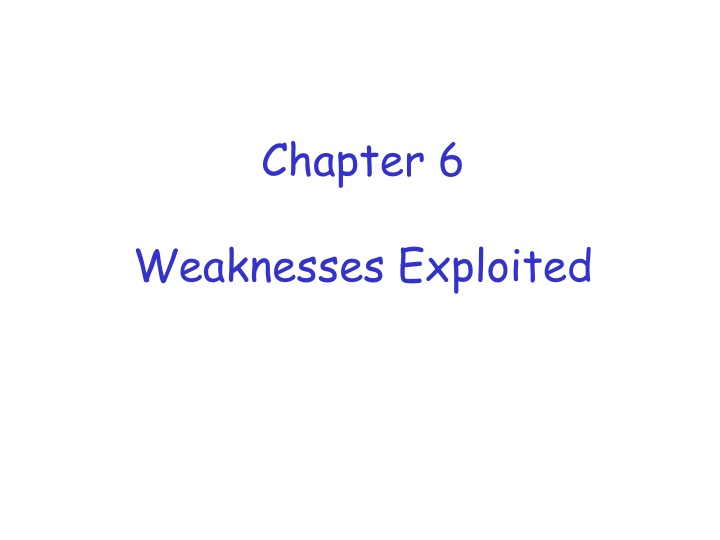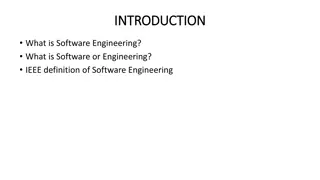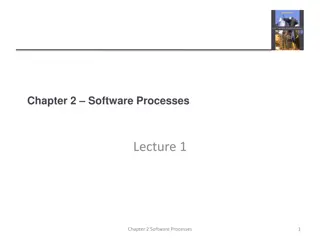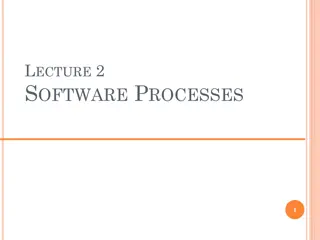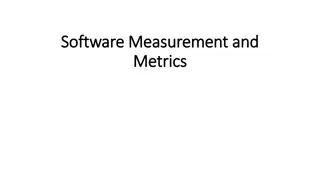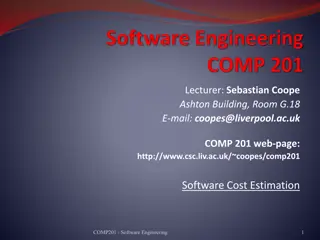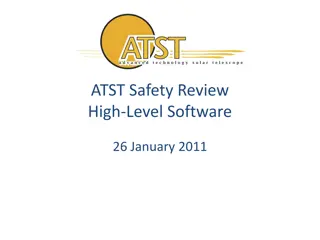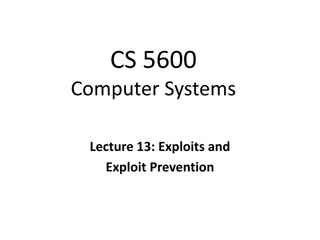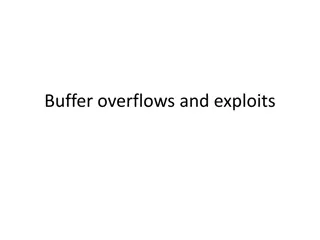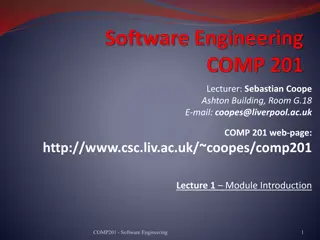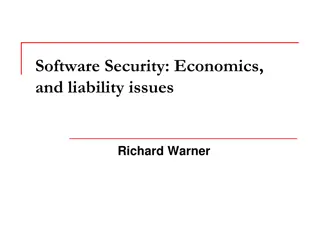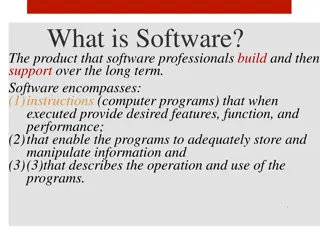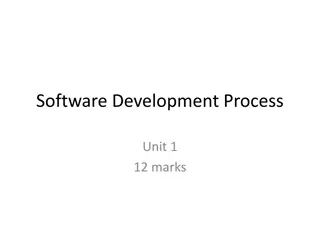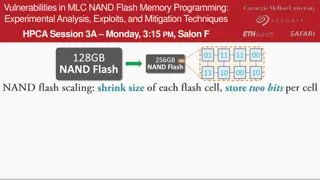Software Weaknesses and Exploits
Discover the vulnerabilities present in software such as buffer overflows and format string vulnerabilities, and how these weaknesses can be exploited to cause security issues. Learn about the technical aspects of weaknesses, stack frames, memory organization, and the potential consequences of stack smashing. Explore scenarios where malicious code injection can occur and the solutions to mitigate such risks.
Uploaded on Sep 07, 2024 | 1 Views
Download Presentation

Please find below an Image/Link to download the presentation.
The content on the website is provided AS IS for your information and personal use only. It may not be sold, licensed, or shared on other websites without obtaining consent from the author.If you encounter any issues during the download, it is possible that the publisher has removed the file from their server.
You are allowed to download the files provided on this website for personal or commercial use, subject to the condition that they are used lawfully. All files are the property of their respective owners.
The content on the website is provided AS IS for your information and personal use only. It may not be sold, licensed, or shared on other websites without obtaining consent from the author.
E N D
Presentation Transcript
Chapter 6 Weaknesses Exploited
Weaknesses Bad software is everywhere, and flaws can cause security problems In this chapter o Various overflow conditions o Format string vulnerabilities o How weaknesses are found o Defenses o Human factors
Technical Weaknesses Buffer overflow Process address space: 4 sections 1. Fixed-sized code block (code/text) 2. Static data (data) 3. Dynamic data (heap) 4. Scratch paper (stack)
Technical Weaknesses C program example
Stack Frame Stack frame allocated for functions Stack holds o Local variables o Book keeping info, such as Input arguments Return address Saved frame pointer, etc.
Stack Frame Stack frame in action
Memory Organization low address text Text == code Data == static variables Heap == dynamic data Stack == scratch paper o Dynamic local variables o Parameters to functions o Return address data heap SP stack high address
Simplified Stack Example low :: void func(int a, int b){ char buffer[10]; } void main(){ func(1, 2); } SP buffer return address SP SP ret a b SP high
Smashing the Stack low What happens if buffer overflows? :: ??? Program returns to wrong location A crash is likely SP buffer ret SP NOT! overflow overflow ret SP a b SP high
Smashing the Stack low Trudy has a better idea Code injection Trudy can run code of her choosing o On your machine! :: SP evil code SP ret ret SP a b SP high
Smashing the Stack :: Trudy may not know 1) Address of evil code 2) Location of ret on stack Solutions 1) Precede evil code with NOP landing pad 2) Insert ret many times NOP : NOP evil code ret ret ret : ret ::
Stack Smashing Note that injected code is usually known as shellcode Other overflow attacks are possible o Some inject code, some don t o We discuss a few more examples later
Stack Smashing Summary A buffer overflow must exist in the code Not all buffer overflows are exploitable o Things must align just right If exploitable, attacker can inject code Trial and error is likely required o Fear not, lots of help available online o Smashing the Stack for Fun and Profit, Aleph One Stack smashing is attack of the decade o Regardless of the decade Also heap overflow, integer overflow, etc.
Stack Smashing Example Program asks for a serial number that the attacker does not know Attacker does not have source code Attacker does have the executable (exe) Program quits on incorrect serial number
Example By trial and error, attacker discovers apparent buffer overflow Note that 0x41is A Looks like ret overwritten by 2 bytes!
Example Next, disassemble bo.exe to find The goal is to exploit buffer overflow to jump to address 0x401034
Example Find that, in ASCII, 0x401034is @^P4 Byte order is reversed? Why? X86 processors are little-endian
Example Reverse the byte order to 4^P@ and Success! We ve bypassed serial number check by exploiting a buffer overflow What just happened? o We overwrote the return address on the stack
Example Note that in this example We overwrote return address and jumped to somewhere interesting We did not inject any code Other interesting places to jump to? o Without injecting code, that is? o Often called return to libc attacks
Example Attacker did not require access to the source code Only tool used was a disassembler to determine address to jump to Possible to find desired address by trial and error? o Necessary if attacker does not have exe o For example, a remote attack
Example Source code of the buffer overflow Flaw easily found by attacker Without the source code!
Stack Smashing Prevention 1st choice: employ non-executable stack o No execute NX bit (if available) o Seems like the logical thing to do, but some real code executes on the stack (Java, for example) 2nd choice: use safe languages (Java, C#) 3rd choice: use safer C functions o For unsafe functions, there are safer versions o For example, strncpy instead of strcpy
Stack Smashing Prevention low :: Canary o Run-time stack check o Push canary onto stack o Canary value: Constant 0x000aff0d Or may depends on ret buffer canary overflow overflow ret a b high
Microsofts Canary Microsoft added buffer security check feature to C++ with /GS compiler flag Based on canary (or security cookie ) Q: What to do when canary dies? A: Check for user-supplied handler Handler shown to be subject to attack o Claims that attacker can specify handler code o If so, formerly safe buffer overflows become exploitable when /GS is used!
ASLR Address Space Layout Randomization o Randomize place where code loaded in memory Makes most buffer overflow attacks probabilistic Vista uses 256 random layouts o So about 1/256 chance buffer overflow works? Similar thing in Mac and other OSs Attacks against Microsoft s ASLR do exist o Possible to de-randomize
Buffer Overflow A major threat yesterday, today, and tomorrow Can greatly reduced overflow attacks o Use safe languages/safer functions o Educate developers, use tools, etc. Buffer overflows will exist for a long time o Legacy code o Bad software development practices
Race Condition Security processes should be atomic o Occur all at once Race conditions can arise when security- critical process occurs in stages Attacker makes change between stages o Often, between stage that gives authorization, but before stage that transfers ownership Example: prepaid debit card
Race Condition Adding cash to card 1. User inserts card into card reader machine 2. Machine reads value of card: x 3. User insert cash into machine: y 4. User presses enter key 5. Machine writes x+y to card 6. Machine ejects card Race condition?
Race Condition Attacks on cash card protocol? Insert 2 cards, sandwiched together Card that is read has $100 value, unread card has $1 value o Step 2: Machine reads x = 100 Insert $2, so y = 2 Pull out read card, leaving unread one Press enter
Race Conditions Race conditions appear to be common in software o May be more common than buffer overflows But race conditions harder to exploit o Buffer overflow is low hanging fruit today To prevent race conditions o Make security-critical processes atomic o Occur all at once, not in stages Not so easy to accomplish in practice
Heap Overflow Heap used for dynamic variables o For example, malloc in C Can overflow one array into another Makes it possible to change data o Like example on next slide
Simple Buffer Overflow Consider boolean flag for authentication Buffer overflow could overwrite flag allowing anyone to authenticate! Boolean flag buffer F O U R S C F T In some cases, Trudy can be more systematic
Heap Overflow Example BEFORE: o buf2 = 22222222 AFTER: o buf2 = 11122222
Heap Overflow Bookkeeping info stored on heap Can attacker exploit this?
Heap Overflow Data structure to keep track of free memory o Assume it is a doubly-linked list Heap overflow attacks?
Heap Overflow Here we free block B Unlink B from heap If overflow in A, can overwrite B s pointers
Heap Overflow Overwrite B s pointers Then free B Now if we ever get to B, will go to shellcode
Integer Overflow Many integer problems This example o What if len is negative? o Note that memcpy thinks len is unsigned
Format String Vulnerabilities Format string example printf( The magic number is %d\n , 42); Format strings: Parameter %d %u %x %s %n Meaning int unsigned int hex string bytes written so far Passed by value value value reference reference
Format Strings and the Stack Formatting functions retrieve parameters from the stack o Assuming that s where they re stored Consider printf( a has value %d at address %d\n , a, &a); What if there are too few arguments? For example printf( a has value %d at address %d\n );
Format Strings and the Stack Consider again printf( a has value %d at address %d\n , a, &a); Here, x1 and x2 are other things on the stack low :: a has \n a address of a x1 x2 high
Format Strings and the Stack What if there are too few arguments? For example printf( a has value %d at address %d\n ); What happens? Print stuff on stack Is this useful? low :: a has \n x1 x2 x3 x4 high
Format String Issue 1 We can walk the stack That is, print out items on the stack For example printf( %08x %08x %08x %08x %08x\n ); As a bonus, it s nicely formatted
Format String Issue 2 What would this do? printf( %s%s%s%s%s%s%s%s%s%s%s ); For each %s function printfwill o Fetch a number from the stack o Treat the number as an address o Print out whatever is at that address, until NULL character Such an address might not exist!
Format String Example What about something like this void print_error(char *s){ char buffer[100]; snprintf(buffer, sizeof(buffer), Error: %s , s); printf(buffer);} Suppose Trudy has control over what goes into the string s Then some interesting possibilities
Format String Issue 3 low return printf Suppose Trudy sets string s to \x78\x56\x34\x12 %d%d%d%s Note \x78 \x12 is little endian for 1234567 What does code on previous slide do? Error: %s 1st %d 2nd %d :: %s :: 1234567 buffer %d %d :: high ::
Format String Issue 4 The %n format is used to print the number of characters written so far Q: What does this do? int i; printf( abcde%n, &i); A: Writes 5 to variable i Can Trudy take advantage of this?
Format String Issue 4 Similar attack as issue 3 except use %n in place of %s Then a value written to address 1234567 o What value? Some claim that this allows writing of arbitrary value o Is this really true?
Format String Defenses Source code auditing o Relatively few format strings Remove support for %n format o Would this create any problems? Keep track of number of arguments General buffer overflow prevention o For example, ASLR (next slide )
More Defenses Mentioned by author o NX approach o Canary o ASLR o Safe/safer languages
